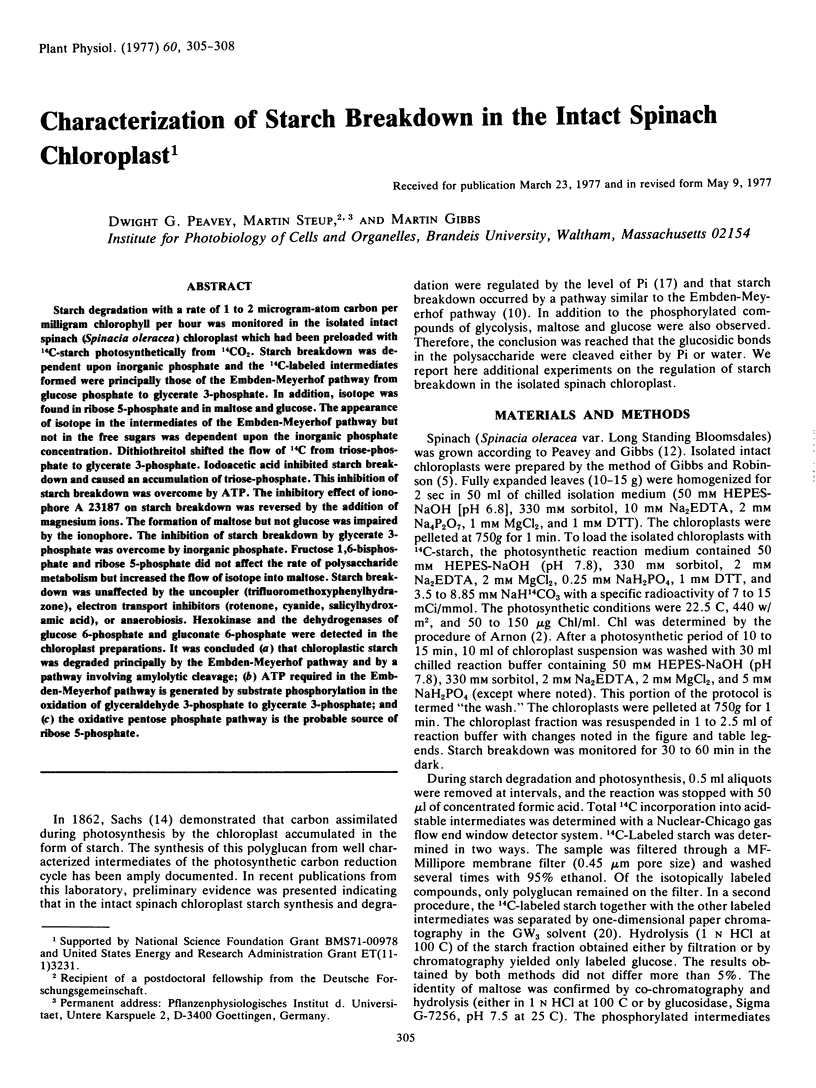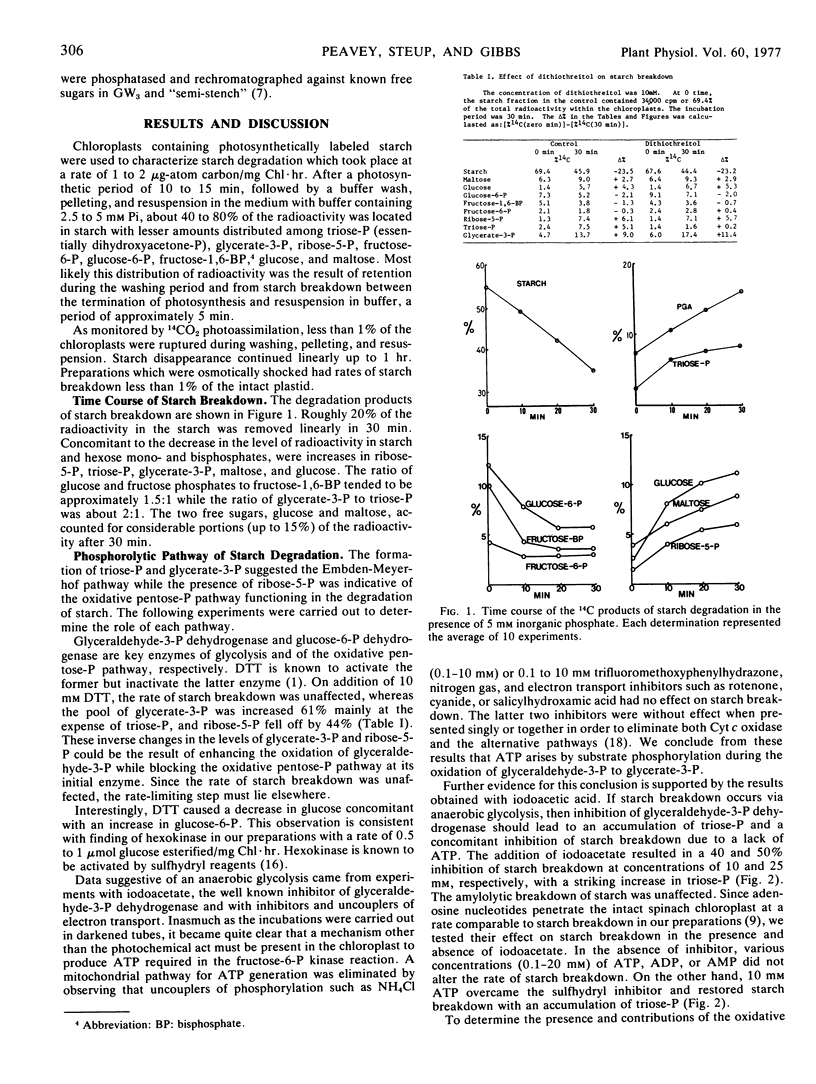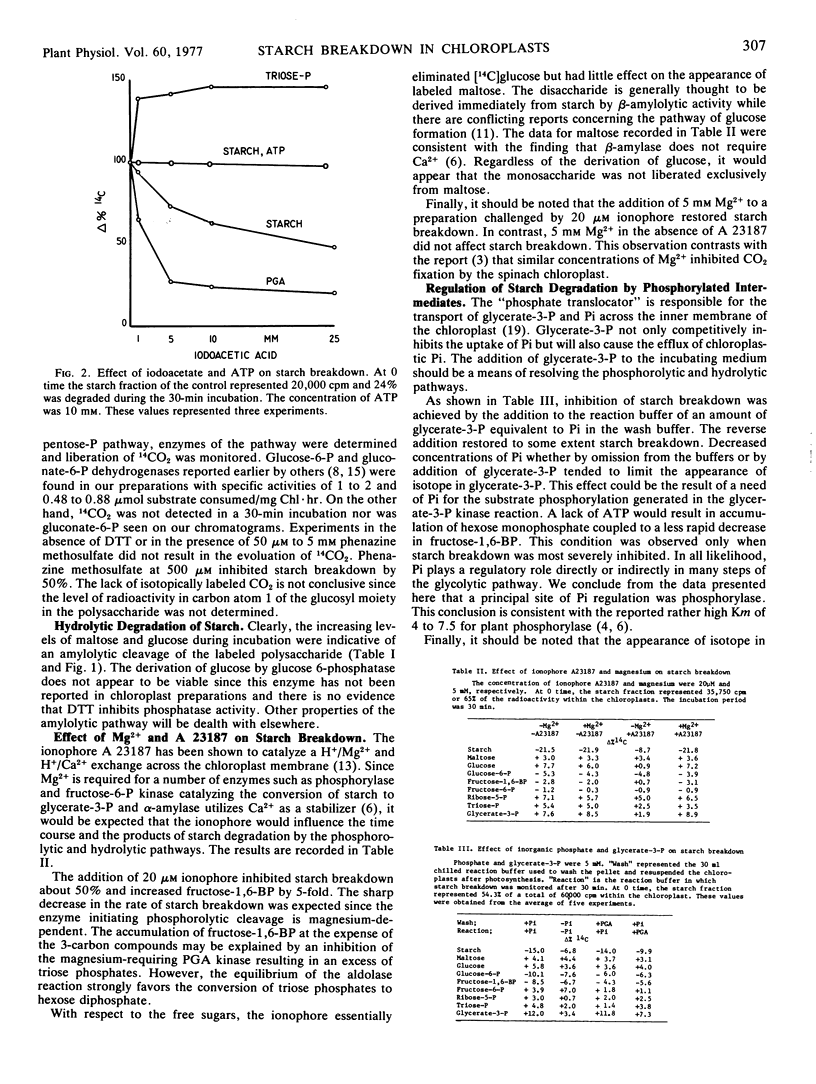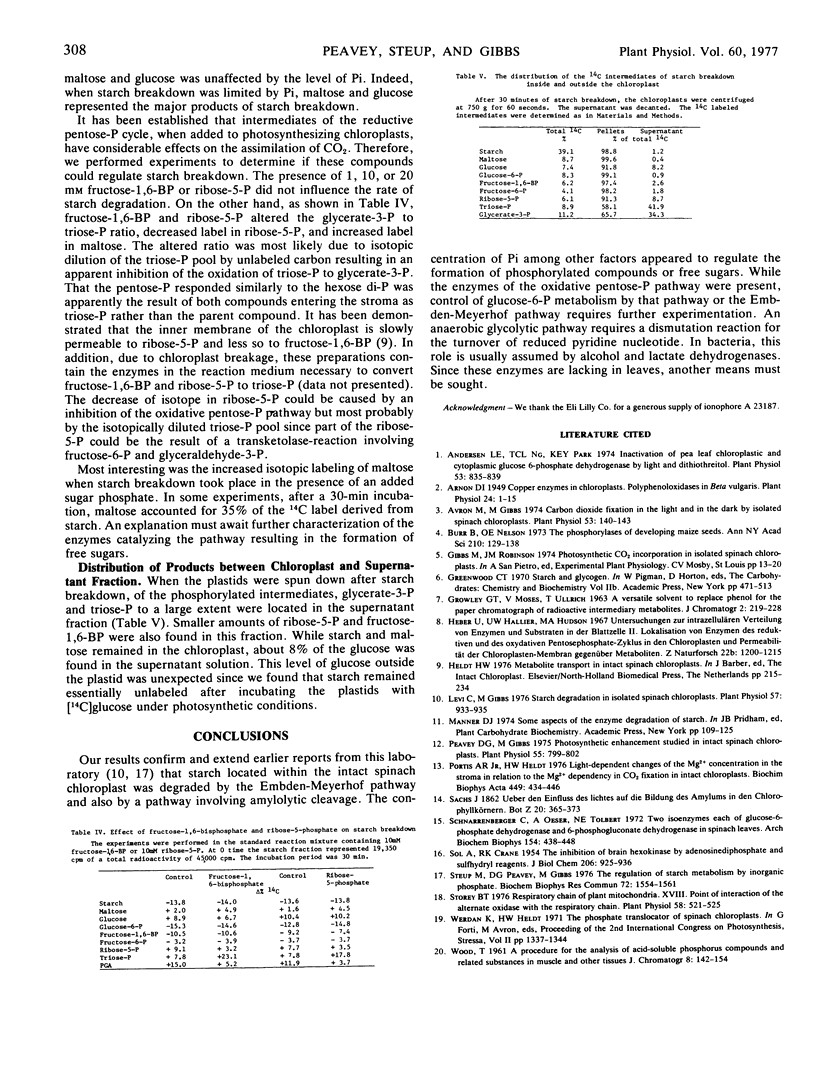Abstract
Starch degradation with a rate of 1 to 2 microgram-atom carbon per milligram chlorophyll per hour was monitored in the isolated intact spinach (Spinacia oleracea) chloroplast which had been preloaded with 14C-starch photosynthetically from 14CO2. Starch breakdown was dependent upon inorganic phosphate and the 14C-labeled intermediates formed were principally those of the Embden-Meyerhof pathway from glucose phosphate to glycerate 3-phosphate. In addition, isotope was found in ribose 5-phosphate and in maltose and glucose. The appearance of isotope in the intermediates of the Embden-Meyerhof pathway but not in the free sugars was dependent upon the inorganic phosphate concentration. Dithiothreitol shifted the flow of 14C from triose-phosphate to glycerate 3-phosphate. Iodoacetic acid inhibited starch breakdown and caused an accumulation of triose-phosphate. This inhibition of starch breakdown was overcome by ATP. The inhibitory effect of ionophore A 23187 on starch breakdown was reversed by the addition of magnesium ions. The formation of maltose but not glucose was impaired by the ionophore. The inhibition of starch breakdown by glycerate 3-phosphate was overcome by inorganic phosphate. Fructose 1,6-bisphosphate and ribose 5-phosphate did not affect the rate of polysaccharide metabolism but increased the flow of isotope into maltose. Starch breakdown was unaffected by the uncoupler (trifluoromethoxyphenylhydrazone), electron transport inhibitors (rotenone, cyanide, salicylhydroxamic acid), or anaerobiosis. Hexokinase and the dehydrogenases of glucose 6-phosphate and gluconate 6-phosphate were detected in the chloroplast preparations. It was concluded (a) that chloroplastic starch was degraded principally by the Embden-Meyerhof pathway and by a pathway involving amylolytic cleavage; (b) ATP required in the Embden-Meyerhof pathway is generated by substrate phosphorylation in the oxidation of glyceraldehyde 3-phosphate to glycerate 3-phosphate; and (c) the oxidative pentose phosphate pathway is the probable source of ribose 5-phosphate.
Full text
PDF



Selected References
These references are in PubMed. This may not be the complete list of references from this article.
- Anderson L. E., Ng T. C., Park K. E. Inactivation of pea leaf chloroplastic and cytoplasmic glucose 6-phosphate dehydrogenases by light and dithiothreitol. Plant Physiol. 1974 Jun;53(6):835–839. doi: 10.1104/pp.53.6.835. [DOI] [PMC free article] [PubMed] [Google Scholar]
- Arnon D. I. COPPER ENZYMES IN ISOLATED CHLOROPLASTS. POLYPHENOLOXIDASE IN BETA VULGARIS. Plant Physiol. 1949 Jan;24(1):1–15. doi: 10.1104/pp.24.1.1. [DOI] [PMC free article] [PubMed] [Google Scholar]
- Avron M., Gibbs M. Carbon dioxide fixation in the light and in the dark by isolated spinach chloroplasts. Plant Physiol. 1974 Feb;53(2):140–143. doi: 10.1104/pp.53.2.140. [DOI] [PMC free article] [PubMed] [Google Scholar]
- Burr B., Nelson O. E. The phosphorylases of developing maize seeds. Ann N Y Acad Sci. 1973 Feb 9;210:129–138. doi: 10.1111/j.1749-6632.1973.tb47567.x. [DOI] [PubMed] [Google Scholar]
- CROWLEY G. J., MOSES V., ULLRICH J. A VERSATILE SOLVENT TO REPLACE PHENOL FOR THE PAPER CHROMATOGRAPHY OF RADIOACTIVE INTERMEDIARY METABOLITES. J Chromatogr. 1963 Oct;12:219–228. doi: 10.1016/s0021-9673(01)83673-6. [DOI] [PubMed] [Google Scholar]
- Heber U., Hallier U. W., Hudson M. A. Untersuchungen zur intrazellulären Verteilungen von Enzymen und Substraten in der Blattzelle. II. Lokalisation von Enzymen des reduktiven und dem oxydativen Pentosephosphat-Zyklus in den Chloroplasten und Permeabilität der Chloroplasten-Membran gegenüber Metaboliten. Z Naturforsch B. 1967 Nov;22(11):1200–1215. [PubMed] [Google Scholar]
- Levi C., Gibbs M. Starch degradation in isolated spinach chloroplasts. Plant Physiol. 1976 Jun;57(6):933–935. doi: 10.1104/pp.57.6.933. [DOI] [PMC free article] [PubMed] [Google Scholar]
- Peavey D. G., Gibbs M. Photosynthetic enhancement studied in intact spinach chloroplasts. Plant Physiol. 1975 May;55(5):799–802. doi: 10.1104/pp.55.5.799. [DOI] [PMC free article] [PubMed] [Google Scholar]
- Portis A. R., Jr, Heldt H. W. Light-dependent changes of the Mg2+ concentration in the stroma in relation to the Mg2+ dependency of CO2 fixation in intact chloroplasts. Biochim Biophys Acta. 1976 Dec 6;449(3):434–436. doi: 10.1016/0005-2728(76)90154-7. [DOI] [PubMed] [Google Scholar]
- SOLS A., CRANE R. K. The inhibition of brain hexokinase by adenosinediphosphate and sulfhydryl reagents. J Biol Chem. 1954 Feb;206(2):925–936. [PubMed] [Google Scholar]
- Schnarrenberger C., Oeser A., Tolbert N. E. Two isoenzymes each of glucose-6-phosphate dehydrogenase and 6-phosphogluconate dehydrogenase in spinach leaves. Arch Biochem Biophys. 1973 Jan;154(1):438–448. doi: 10.1016/0003-9861(73)90077-5. [DOI] [PubMed] [Google Scholar]
- Steup M., Peavey D. G., Gibbs M. The regulation of starch metabolism by inorganic phosphate. Biochem Biophys Res Commun. 1976 Oct 18;72(4):1554–1561. doi: 10.1016/s0006-291x(76)80191-x. [DOI] [PubMed] [Google Scholar]
- Storey B. T. Respiratory Chain of Plant Mitochondria: XVIII. Point of Interaction of the Alternate Oxidase with the Respiratory Chain. Plant Physiol. 1976 Oct;58(4):521–525. doi: 10.1104/pp.58.4.521. [DOI] [PMC free article] [PubMed] [Google Scholar]


